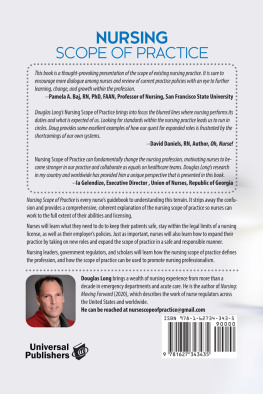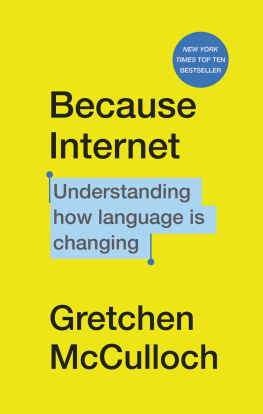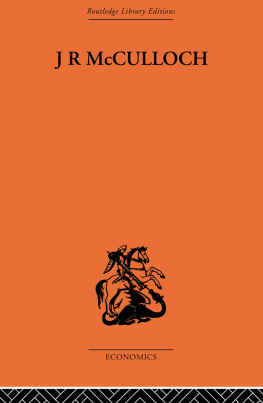Valuing Health in Practice
To Noreen
First published 2003 by Ashgate Publishing
Reissued 2019 by Routledge
2 Park Square, Milton Park, Abingdon, Oxon, OX14 4RN
52 Vanderbilt Avenue, New York, NY 10017
Routledge is an imprint of the Taylor & Francis Group, an informa business
Copyright Douglas McCulloch 2003
The author has asserted his moral right under the Copyright, Designs and Patents Act, 1988, to be identified as the author of this work.
All rights reserved. No part of this book may be reprinted or reproduced or utilised in any form or by any electronic, mechanical, or other means, now known or hereafter invented, including photocopying and recording, or in any information storage or retrieval system, without permission in writing from the publishers.
Notice:
Product or corporate names may be trademarks or registered trademarks, and are used only for identification and explanation without intent to infringe.
Publishers Note
The publisher has gone to great lengths to ensure the quality of this reprint but points out that some imperfections in the original copies may be apparent.
Disclaimer
The publisher has made every effort to trace copyright holders and welcomes correspondence from those they have been unable to contact.
A Library of Congress record exists under LC control number:
ISBN 13: 978-1-138-72172-2 (hbk)
ISBN 13: 978-1-138-72170-8 (pbk)
ISBN 13: 978-1-315-19419-6 (ebk)
Social priorities tend not to be of interest to physicians, possibly because they are trained to focus on the health needs of individuals, not groups, and they can be reluctant to examine prioritisation issues. The pages that follow tease out some of the complexities, particularly those identified by economists.
The pharmaceutical companies are spending millions on the making of value judgements by economists, because governments have begun to require evidence that new drugs and other health technologies give value for money. This term is often imprecisely defined, and the evidence, when collected, is not always used as the basis for action. Their commercial interests should not prevent pharmaceutical companies from greater engagement in prioritisation debates, and the issues explained here are also relevant to them.
Perhaps economists do not often enough explain the importance of trying to get the most from the resources available. Most people are involved in health care as either patients or carers, so that they become focussed on one condition, to the exclusion of all others. Just what it means to think socially about health is new to most people, as some of the experience reported here has shown, but it is not impossible, nor even difficult, if the ideas are carefully presented.
In the richest societies, there continues to be an interest in social mechanisms for resource allocation which are beyond the market and the centrally planned economy. Health care provision has a high political priority in most countries; it also involves the requirement to provide basic care as well as advanced technological solutions, in a manner which respects basic human values. While strategies for valuing health in practice cannot be described as templates for dealing with other modern problems, an understanding of these particular issues may provide lessons which have wider relevance.
I would like to thank Professor Charles Normand, of the London School of Hygiene and Tropical Medicine.
Thanks are also due to:
Dr. M. Barry, Director, and Dr. M. Ryan, Senior Pharmacist, Irish Centre of Pharmacoeconomics, Dublin; Dr. R. Cookson, London School of Economics and Political Science; Dr. E. Kula, University of Ulster; Professor A. Maynard, London School of Economics and Political Science; Dr. D. McDaid, London School of Economics and Political Science; Ms. P. McKee, University of Ulster; Mr. H. OKane, Cardiac Surgeon, Royal Victoria Hospital, Belfast; Dr. C. ONeill, University of Ulster;
Patricia McKee, at the University of Ulster, was indispensable to all aspects of the computing work required to get this book written and into print.
The errors and omissions that remain are mine.
Dr. Kinds permission to reproduce material derived from the MVH Project investigation of EuroQol 5-D, the Rosser-Kind collaboration, and the Health Measurement Questionnaire, Professor Patricks permission to reproduce the statements from the Functional Limitations Profile, and Dr. McKennas permission to reproduce the statements from the Nottingham Health Profile, are all gratefully acknowledged.
| ASTEC | Analysis of the Scientific and Technical Evaluation of Health Interventions |
| CBA | Cost-Benefit Analysis |
| CEA | Cost-Effectiveness Analysis |
| CMA | Cost-Minimisation Analysis |
| CUA | Cost-Utility Analysis |
| EPMST | Extended Post-Marketing Surveillance Trial |
| EHI | Evaluation of Health Interventions |
| EQD | Expected QALY Deficit |
| FLP | Functional Limitations Profile |
| HMQ | Health Measurement Questionnaire |
| hrqol | health-related quality of life |
| MEQI | Mean Expected QALY Indicator |
| NHP | Nottingham Health Profile |
| PBMA | Programmed Budgeting and Marginal Analysis |
| QALY | Quality Adjusted Life Year |
| RCT | Randomised Controlled Trial |
| SIP | Sickness Impact Profile |
Chapter 1
Priorities, QALYs, and Choice
Introduction
During a research project valuing health states, a heart bypass candidate expressed suicidal intent during two separate interview sessions. This patient had been waiting months for the procedure; he could barely get out of his chair without help, he was unable to read or talk for more than a few minutes at a time, and his responses to the questionnaires registered zero quality of life. The surgeon was told of the researchers fear that the patient might kill himself; a few weeks later, the patient received the bypass.
Without the two research interviews, this patient might have died before the operation took place; this chance occurrence probably prolonged his life, and improved its quality. Clearly, it would have been better if his quality of life and survival prospects had been assessed on some routine, consistent basis, and compared with the health of other patients who were waiting for the same procedure. This would have brought his very poor quality of life to the surgeons notice, without the need for a consultation; it might also have caused the procedure to have gone to someone with the same quality of life, and a better chance of survival. But in either case, his quality of life and survival prospects would have been taken into account as a matter of routine, rather than by chance. This is possible because reliable questionnaires have been developed, which can determine patient quality of life, and measure health outcomes; for a variety of reasons, they have not been routinely applied in health services.
Even when formal measures are not being used, health sector choices imply health valuation. Suppose a hospital can, for the same cost, increase either the number of neo-natal intensive care places, or the number of hip joint replacements; selecting one and not the other values its outcomes more, whether or not quality of life information are available. Similarly, the allocation of respite days between carers, when not all can have a break, effectively values the need of some carers more than others. Health valuation is thus the consequence of scarcity and the need for choice.











